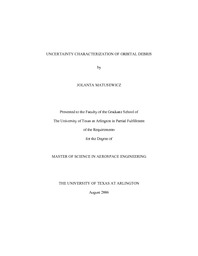
ATTENTION: The works hosted here are being migrated to a new repository that will consolidate resources, improve discoverability, and better show UTA's research impact on the global community. We will update authors as the migration progresses. Please see MavMatrix for more information.
Show simple item record
| dc.contributor.author | Matusewicz, Jolanta | en_US |
| dc.date.accessioned | 2007-08-23T01:56:23Z | |
| dc.date.available | 2007-08-23T01:56:23Z | |
| dc.date.issued | 2007-08-23T01:56:23Z | |
| dc.date.submitted | August 2006 | en_US |
| dc.identifier.other | DISS-1491 | en_US |
| dc.identifier.uri | http://hdl.handle.net/10106/259 | |
| dc.description.abstract | The increase of orbital debris in the low Earth orbit is a concern for the space industry. Spacecraft and satellites are at risk of collision with orbital debris. Collisions can damage sensitive components or result in catastrophic failure. Organizations such as the United States Space Command are responsible for tracking orbital debris using ground based sensor sites located around the world. Orbit determination techniques are used to estimate the position and velocity of the orbit using range, azimuth, and elevation measurements obtained from the sensors.
Nine sensors from the Space Surveillance Network are simulated to track a debris object in an International Space Station orbit. Perturbations due to a 4 X 4 complex gravity model and an exponential atmospheric model are included in the two-body orbital equations of motion force model. The nonlinear batch least squares and the continuous-discrete extended Kalman filter techniques are used to estimate the debris orbit. | en_US |
| dc.description.sponsorship | Subbarao, Kamesh | en_US |
| dc.language.iso | EN | en_US |
| dc.publisher | Aerospace Engineering | en_US |
| dc.title | Uncertainty Characterization Of Orbital Debris | en_US |
| dc.type | M.S.E. | en_US |
| dc.contributor.committeeChair | Subbarao, Kamesh | en_US |
| dc.degree.department | Aerospace Engineering | en_US |
| dc.degree.discipline | Aerospace Engineering | en_US |
| dc.degree.grantor | University of Texas at Arlington | en_US |
| dc.degree.level | masters | en_US |
| dc.degree.name | M.S.E. | en_US |
| dc.identifier.externalLink | https://www.uta.edu/ra/real/editprofile.php?onlyview=1&pid=295 | |
| dc.identifier.externalLinkDescription | Link to Research Profiles | |
Files in this item
- Name:
- umi-uta-1491.pdf
- Size:
- 6.689Mb
- Format:
- PDF
This item appears in the following Collection(s)
Show simple item record


